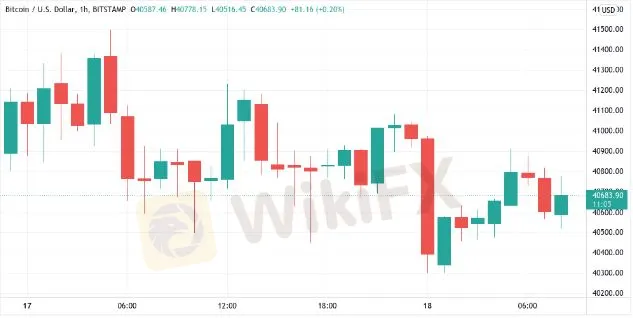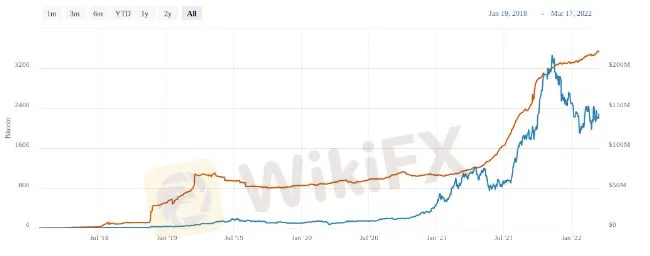简体中文
繁體中文
English
Pусский
日本語
ภาษาไทย
Tiếng Việt
Bahasa Indonesia
Español
हिन्दी
Filippiiniläinen
Français
Deutsch
Português
Türkçe
한국어
العربية
Bitcoin holds $40K as on-balance volume hints at multi-month BTC price breakout
Abstract:It could soon be time to call an end to the trading range in which Bitcoin has languished throughout 2022.
Bitcoin (BTC) narrowed its consolidation range on March 18 as the TradFi trading week looked set to end with $40,000 still in place.

BTC/USD 1-hour candle chart (Bitstamp). Source: TradingView
Traders patiently await paradigm shift
Data from Cointelegraph Markets Pro and TradingView showed BTC/USD preserving $40,000 support overnight, and with it the area highlighted as “crucial” by analysis Thursday.
Macro cues had lessened following the United States Federal Reserve rate hike confirmation, with a lack of new triggers from Europe steadying markets overall.
For popular trader Crypto Ed, the next few days should see either a continuation to a target zone of $43,000 or a breakdown of the current trend.
Analyzing his Elliot Wave setup for the 4-hour BTC/USD chart, however, he noted that the cycle was “still bearish” prior to a range high of $45,000 being broken — something which could happen after another few consolidatory moves in between.
Those moves, specifically a strong bounce during the retracement, “would be my signal to go long,” he said in a YouTube update Thursday.
Other participants were increasingly bullish on the outlook, too, with Twitter trader Zima even highlighting a long-term trend breakout for on-balance volume (OBV).
As Cointelegraph previously reported, increasing OBV reflects growing demand for an asset at the current traded price, and for Bitcoin, the time appeared to be night for exiting a sideways price zone in place since as far back as January 2021.
“I havent moved a single line on my OBV since I started tracking the move 8 weeks ago,” Zima commented.
“We have broken out of the wedge to the top side and are flipping the 20 day OBVMA. We are on the cusp of a multi month bullish continuation after a year of crab.”
Lightning Network reaches new capacity highs
The week came with a new achievement for Bitcoin network growth, notably the Lightning Network, which passed 3,500 BTC capacity.
Related: Bitcoin faces new ‘milestone’ in 2022 as new forecast predicts BTC price ‘in the millions’
Part of the so-called “Layer 2” technology on Bitcoin, Lightning allows instantaneous off-chain transactions to be sent en masse at practically zero cost.
The technology has been in place for several years, and has quietly grown behind the scenes to cater to increasing volume and mainstream consumers.
“Don't sleep on the Lightning Network, which continues to grow at an impressive pace,” on-chain analyst Dylan LeClair commented on the statistics.

Disclaimer:
The views in this article only represent the author's personal views, and do not constitute investment advice on this platform. This platform does not guarantee the accuracy, completeness and timeliness of the information in the article, and will not be liable for any loss caused by the use of or reliance on the information in the article.
Read more

Top Tips to Avoid Forex Margin Calls and Protect Your Capital
While technical indicators or chart patterns often capture the attention of forex traders, especially new ones, aspects such as margin requirements, equity, used margin, free margin, and margin levels are often overlooked. So, if you have received a margin call from your forex broker and are wondering how to deal with it, you probably do not know the concept of a forex margin call - what triggers it and how to avoid it. Being unaware of this concept can make you lose your hard-earned capital. In this article, we will provide you with all the information you need to know. Keep reading!

US-China Tariffs Heat Up—Pause Still Possible, Says Bessent
President Trump signaled the U.S. and China are effectively in a trade war, even as Treasury Secretary Scott Bessent left room to extend a current tariff pause and a Trump–Xi meeting remains on the calendar. After floating a new 100% tariff on Chinese goods from Nov. 1, tensions seesawed amid Chinese sanctions and U.S. threats over soybeans. Some U.S. tariffs (up to ~145%) are paused until Nov. 10, with a Supreme Court test of “reciprocal” tariffs looming. Companies are adapting unevenly—Stellantis expanding in the U.S., while Apple deepens ties in China—suggesting continued market volatility.

Crypto, Euro, Yuan: Still No Dollar Killer
Despite frequent “de-dollarization” headlines, the U.S. dollar remains unrivaled due to unmatched market depth, global usability, and trusted legal/institutional frameworks. Crypto and other currencies (euro, yuan) lack the stability, convertibility, and infrastructure required to replace the USD, while the Fed’s credibility and the scale of U.S. financial markets continue to anchor demand. Bottom line: no alternative currently offers a complete, credible substitute for the dollar’s global role.

Standard Deviation in Forex: How to Apply This to Your Trading Strategy?
Do you recall the concept of standard deviation being taught in your school days? The concept, which measures the variation within a set of data points relative to the mean average of the dataset. A greater standard deviation hints at higher variability. On the other hand, a lower standard deviation means lower variability from the mean. But what is standard deviation in forex, and how can you apply it to your trading strategy? This is what we will discuss here.
WikiFX Broker
Latest News
UAE Launches Sixth 'Caution' Campaign to Combat Forex and Online Investment Fraud
US and UK Sanction Cambodia-Based Prince Group Over $16B Scam
David Stockman On How The Fed's Money Printing Broke American Industry... And What Comes Next
Forex24 Faces CySEC Fine for Late Compliance Filing
"Our Business Has Died": Texas Services Sector Sentiment Slumps Further In October
One Wrong Move Wiped Out a Government Retiree’s Lifetime Savings
D Prime to Exit Limassol Office Amid Doo Group Restructure
Mekness Review: Traders Report Alleged Fund Scams & Account Blocks
INTERPOL, AFRIPOL Crack Down on Africa Terror Finance
Forex Scam Checker Philippines: Verify Brokers with WikiFX
Currency Calculator




